Jul 19, 2024 Welcoming Activities for Meaningful Engagement, Community Building, and Reflection
Strong Beginnings
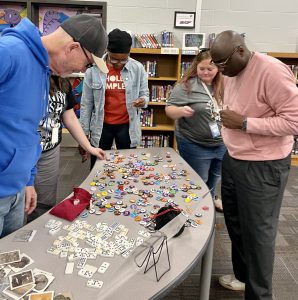 The first few minutes of an experience are a key time to hook and engage learners, create context for learning, and set a welcoming tone. A novel and inclusive activity immediately engages learners— drawing them into a positive experience and creating buy-in. Participants come to class/meeting/training with things on their minds— a rough morning at home, a stressful commute, a challenging social interaction in the hallway before class, or the deadline they are trying to meet.
The first few minutes of an experience are a key time to hook and engage learners, create context for learning, and set a welcoming tone. A novel and inclusive activity immediately engages learners— drawing them into a positive experience and creating buy-in. Participants come to class/meeting/training with things on their minds— a rough morning at home, a stressful commute, a challenging social interaction in the hallway before class, or the deadline they are trying to meet.
In many posts over the years, and in both of my books, I’ve shared how a reflective, focusing activity can help participants transition into the workshop/meeting space and shift their focus to the present and the lesson at hand. Research on learning and retention shows that people remember most about the first few minutes of an experience and, secondly the last few minutes of experience (Willis, 2014). Cognitive neuroscientists call this the primacy-recency effect.
John Medina, author of Brain Rules, states: “If you are trying to get information across to someone, your ability to create a compelling introduction may be the most important single factor in the later success of your mission” (2008, p. 116). This information validates the importance of welcoming participants with an engaging opening activity and providing a meaningful reflection prompt to tie it all together or “bookend” a learning experience. I like the language around this practice that I’ve seen promoted by leaders in Social and Emotional Learning who use the terms “welcoming ritual” and “optimistic ending” to describe this practice of intentionally infusing welcoming and closing rituals into group sessions.
Here are some examples:
Postcards, Images, and Object “Hooks”
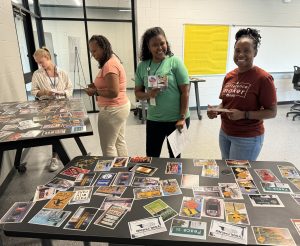 My favorite methods for engaging and welcoming learners from the moment they walk in the door involve the use of object or image-based reflection prompts such as postcards, found images, paint chips, computer keyboard keys, Miniature Metaphors, tools, and other found objects, natural objects, animal figurines or pictures, and household items.
My favorite methods for engaging and welcoming learners from the moment they walk in the door involve the use of object or image-based reflection prompts such as postcards, found images, paint chips, computer keyboard keys, Miniature Metaphors, tools, and other found objects, natural objects, animal figurines or pictures, and household items.
People of all ages are drawn in by colorful, novel, or intriguing imagery and objects. They often reflect and share more readily when they can attach their thoughts and feelings to an item that can be touched and shown to a group during discussion or described in reflective writing.
Brain research suggests that using metaphors, pictures, and symbols helps cement lessons and transfer learning to everyday life and future experiences (Willis, 2010). Visit these links to read more about using postcards, images, and objects as a welcoming strategy, including some prompt examples.
Quotes, Pin-Back Buttons, and Compelling Questions
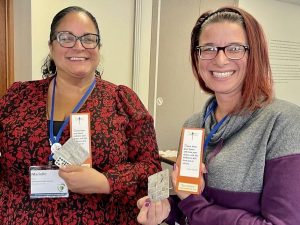 Quotes: Opening a class/session by offering a variety of quotes with a context or theme related to your lesson or group goal is a powerful way to engage, create context and “frame” or “anchor” a lesson or upcoming experience by creating relevancy and emotional connection to the content. Quotes are an engaging transitional, introductory, or reflective activity and a compelling way to explore an academic subject or discussion topic. Discussing quotes can help group members connect with each other or spark creative thought around a subject. To read more examples of the use of quotes, check out this post from the blog archives. For quotes centered around the theme of experiential learning and change, see my Quotables collection.
Quotes: Opening a class/session by offering a variety of quotes with a context or theme related to your lesson or group goal is a powerful way to engage, create context and “frame” or “anchor” a lesson or upcoming experience by creating relevancy and emotional connection to the content. Quotes are an engaging transitional, introductory, or reflective activity and a compelling way to explore an academic subject or discussion topic. Discussing quotes can help group members connect with each other or spark creative thought around a subject. To read more examples of the use of quotes, check out this post from the blog archives. For quotes centered around the theme of experiential learning and change, see my Quotables collection.
Simply posing a brain teaser, word puzzle, or reflective prompt to think or talk about as participants enter can be an easy-to-plan welcoming/focus strategy. Tools like Table Topics and Chat Pack cards are valuable resources for these question prompts and can be found at your local independent bookstore. When using question prompts, I infuse choice into the activity by displaying an assortment of questions and inviting participants to choose a question they would like to chat about with a partner rather than handing questions out or having them blindly receive a question.
Conversation Starter Buttons or Paint Chips
Conversation-Starter Buttons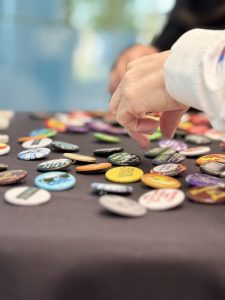 or paint chips/samples are a fun and easy way to transition into a classroom or workshop space. they are a perennial favorite in my professional development and adult learning programs, and I regularly use them to check progress around group projects. This is also a tried-and-true activity for engaging educators or leaders in laughter and dialogue during a professional development session. The buttons bring humor into group settings where individuals are reluctant to participate, helping them buy into the group process. If you don’t have access to the buttons, paint chips can be used similarly. I choose paint samples from my local hardware store based on the paint name as well as color.
or paint chips/samples are a fun and easy way to transition into a classroom or workshop space. they are a perennial favorite in my professional development and adult learning programs, and I regularly use them to check progress around group projects. This is also a tried-and-true activity for engaging educators or leaders in laughter and dialogue during a professional development session. The buttons bring humor into group settings where individuals are reluctant to participate, helping them buy into the group process. If you don’t have access to the buttons, paint chips can be used similarly. I choose paint samples from my local hardware store based on the paint name as well as color.
Graffiti Wall, Group Drawing, or Sculpture:
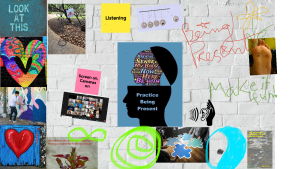 There is great power when participants create symbols, music, words, or performance to represent feelings and experiences. The very essence of art is expressing oneself. Throughout history, humans have used artistic expression to explore, understand, and share ideas and experiences. Involvement in individual/group art activities can be a rich, reflective process for participants. My favorite collaborative artistic methods that are engaging warm-up, entry or ongoing reflection activities include Group Drawing/Sculpture and Graffiti Wall. Online variations can be found in these past articles from the blog.
There is great power when participants create symbols, music, words, or performance to represent feelings and experiences. The very essence of art is expressing oneself. Throughout history, humans have used artistic expression to explore, understand, and share ideas and experiences. Involvement in individual/group art activities can be a rich, reflective process for participants. My favorite collaborative artistic methods that are engaging warm-up, entry or ongoing reflection activities include Group Drawing/Sculpture and Graffiti Wall. Online variations can be found in these past articles from the blog.
Creating an inclusive welcoming activity, first five, or hook activity to start a session or class creates an opportunity for participants to make positive connections with their peers and set up context around the upcoming experience or lesson. This begins the process of reflection and shifts focus to the here and now. It is an essential engagement tool that reaps great rewards for ongoing reflection and engagement in content throughout the rest of the program. For more ideas, visit Chapter Three of the Inspired Educator, Inspired Learner: Experiential, Brain-Based Activities and Strategies to Engage, Motivate, Build Community, and Create Lasting Lessons book for more Welcoming Activities and Hooks to engage, reflect and connect.
*Continue the Inclusive Welcome and “Hooks to Engage” with Interactive Pair Share and Small Group Connection activities before facilitating formal introductions, circles or content. See these previous posts or the Inspired Educator book for more ideas.



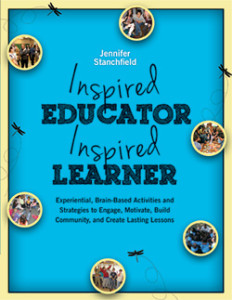
No Comments